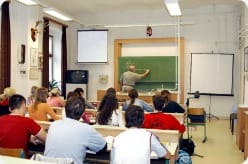Life Science Teacher Certification

Life science impacts people’s lives every day. It is essential to the understanding of disease, diversity of life and all biological topics. It would be nearly impossible to make informed decisions about everything from disease treatment to how to improve crop yields without advanced life science education. Life science teachers are, therefore, a necessary part of any high school’s faculty as they guide the education of future scientists, technicians, and other biological science workers.
On This Page…
In 2005, fifteen of the country’s most important business organizations released a report asserting that the United States should double the number of science, technology, mathematics and engineering bachelor’s degree holders by 2015. According to the report (“Tapping America’s Potential: The Education for Innovation Initiative”), by their senior year, U.S. students are at the bottom of the rankings in international competitions in these subjects. As the U.S. increases its educational focus on the sciences, the need for certified, experienced life science teachers will likely increase.
Life science certification is the first step in becoming a high school biology or general life sciences teacher. Certification is like a resume stamp that demonstrates a strong understanding of the intricacies of the biological sciences and pedagogy.
What is Certification?
- Ecology
- Aquatic Ecology
- Genetics & Molecular Biology
- General & Organic Chemistry
- Calculus
- Statistical Methods
- Biology
- Bacterial & Insect Biology
- Animal & Plant Physiology
- Immunobiology
School districts strive to achieve excellence in math and science, and hiring qualified, certified teachers is the first step they must take to successfully educate their students in these subjects. Becoming certified tells a school district that a teacher has met the state’s basic requirements for being a life science teacher. Moreover, it demonstrates that the teacher understands the most current theories and practices in teaching all areas of life sciences.
Certification requires a new teacher to meet several requirements before a state’s department of education approves a license. First, teachers must have at least a bachelor’s degree. This degree typically needs to be in the area the educator wishes to teach and include a teaching practicum or student teaching component. Second, the teacher must file an application with the state to become a licensed teacher. The application requires a teacher to prove a clear criminal history through a background check. Finally, a future life science teacher must also submit university transcripts to the state’s department of education and take an exam that demonstrates competence in biology.
Content Knowledge and Lab Activities
Life science teachers are expected to understand cell and molecular biology, evolution and genetics, among other topics before they are certified. Furthermore, a teacher may be required to outline lesson objectives in which students learn through discovery in essay form on the certification exam. Life science teachers must be able to set-up and help students conduct such experiments and activities.
- Students design their own experiments involving Jell-O that molds. (Possibly answering questions like, “Can mold grow on a substance that does not have water in it?”
- Students could study the diversity of invertebrate life by examining earthworms, crayfish, crickets and mealworms.
- Students can simulate the processes of mitosis, meiosis and fertilization with model chromosomes made from socks.
One basic goal of life science studies is to gain a basic understanding of plants, animals and how they interact. Students can do this in a high school classroom through laboratory activities that involve dissection, experimentation and other activities that encourage curiosity and inquiry. Science constantly seeks out new questions to answer and incorporating these types of activities into lessons will help students learn to think independently and critically about life science as well as other areas.
One possible lab activity is a fictional case study involving blood types. In a mock crime scene situation, students could decide who the criminal is after testing blood types of suspects and from samples found at a crime scene. Students could also learn about DNA, cell characteristics and biological molecules in an experiment in which they extract DNA from their cheek cells or split peas. Additionally, a life science teacher might wish to explore the relationships in different ecosystems with her students. She could do this through a field trip to a local ecosystem. There, students could take notes on the evidence of different partnerships and relationship webs they observe.
Hands-on activities in which students can relate biology to the world they know is much more effective than if they just read about cells and evolution in a textbook. According to Christina Hart and other science teachers (2000) who authored an article with her for the Journal of Research in Science Teaching, laboratory experiments often fail to achieve the desired result of helping students learn because students do not usually understand the purpose behind their lab activities. Having a clear goal for each experiment is vital, and ensuring students understand it is important to their learning and retaining lesson material.
Why Life Science Teachers are Important
Life science teachers provide the foundation in biology that many students need later in college. A good life science teacher can set a student up for success in future courses that require a basic understanding of biology. Having a comprehensive understanding of basic biology helps students acquire entry-level scientific positions such as lab technologist or veterinary technician, and it is vital for entering higher studies in biology to become a doctor or researcher. The American Institute of Biological Sciences cites the Bureau of Labor Statistics’ estimate that there will be a significant growth in the number of jobs in the molecular biology and biotechnology sectors in the coming years. Students with a good understanding of biology are positioned to enter these growing fields with confidence.
Life science teachers are also vital to helping students learn about not only biology, but also the process of scientific inquiry. Students who regularly practice critical thinking skills, hypothesizing, and experimentation are, generally, better innovators and creators. They have had practice thinking beyond what is right in front of them. They have manipulated variables and considered those that are not plainly in sight. They view global problems from more than one angle and are better positioned to posit new solutions to old problems.
A certified life science teacher also plays an integral role in increasing the number of students who achieve scientific greatness in the United States. America will be competing with many others in the coming years to discover the latest cures in medicine and in general understanding of animal and plant life. Life science teachers who inspire their students to learn more about biology and to pursue further studies in it influence the next generation of the nation’s scientists.
How Certification as a Life Science Teacher Will Prepare You to Teach
Certification does more than say that a graduate in life sciences is qualified to teach. It helps a teacher think through the process of how to present complex life science lessons in an interesting and engaging way. Teachers learn to design lab experiments, discover activities and lectures so that students want to learn during the certification process. The UK’s Society of Biology further underscores the importance of practical biology in its statement that lab experiments give students active practice in using the scientific method to learn new information. Lab activities also visually illustrate concepts and promote teamwork and problem-solving, which leads to greater lesson retention.
Life science teachers also learn to utilize the latest technology to enhance their lessons. For example, teachers can collaborate with other students, researchers and teachers through several online life science projects. This makes learning more interactive, real-time, and authentic. When students take measurements and share their data with real biological researchers in projects like GLOBE (Global Learning and Observations to Benefit the Environment), they are more likely to be active, participatory learners.
Additionally, certification helps teachers consider the best ways to evaluate and assess their students. Final projects that incorporate research and experimental skills, for example, may demonstrate more of what a student understood throughout a school term than a multiple-choice test. Without a clear vision of how to present, instruct and assess, life science teachers are likely to be left with a lab full of confused students and little idea of how effective their lessons have been.
Finally, having certification as a life science teacher helps teachers know they can accurately convey life science knowledge to their students. As new teachers may not always be confident in their teaching, just knowing that they completed the certification process can be just the self-esteem boost a new teacher needs.
How to Become a Life Science Teacher
Life science certification is the first step to a rewarding career as a high school life sciences or biology teacher. Learn about your state’s certification requirements, here. The National Association of Biology Teachers and the Federal Resource for Educational Excellence are also helpful life science resources to keep up-to-date about the latest in professional development for educators.




